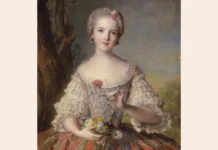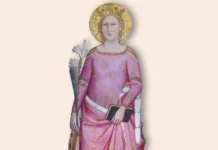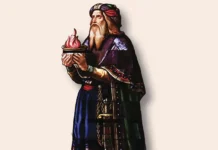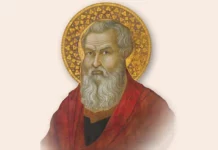St. Basil, the Father of Eastern monasticism, is called “the Great” because of his excellence in governing his diocese, but most especially for his defence of the Blessed Trinity against the Arian heresy.
The fourth century of the Christian era could be described as an age of theological controversy. But it was also a golden era for the Church, since, precisely because of this, illustrious figures arose in defence of the Faith, including three splendid Cappadocians who were intertwined in this golden chain of fidelity: St. Gregory Nazianzen, St. Gregory of Nyssa and his brother St. Basil the Great, the subject of this article.

A family of Saints
Born in Caesarea, Cappadocia, around the year 330, Basil belonged to a wealthy and noble Christian family. Some years before his birth, the Church had received freedom of worship from Constantine, ending the period of the great persecutions. It is said that his paternal grandparents were among the Christians who, during the reign of Diocletian, had to take refuge for many years in the forests of the region, in order to survive without renouncing the Faith.
His parents were exemplary in the practice of virtue and in charity toward neighbour, dedicating a portion of their possessions to the poor, the sick, and the needy. They had ten children, among whom, in addition to St. Basil, were the outstanding Macrina, Gregory, Bishop of Nyssa, and Peter, Bishop of Sebaste, all raised to the honour of the altars.
During his childhood, he received his first religious instruction, from his grandmother, also a saint, named Macrina. 1 He thus described her salutary influence: “What argument could be more convincing to prove the authenticity of our faith, than the fact that we were educated and guided by that blessed lady born among you? I refer to Macrina, the illustrious lady, from whom we learned the words of the most blessed Gregory, the Thaumaturge. All of it was received from an uninterrupted oral tradition, which she faithfully kept in her heart. She shaped our soul while still young and introduced it onto the path of piety.” 2
From childhood, Basil demonstrated a fiery soul and an energetic temperament, but this was joined with a gentleness toward others that marked his entire earthly journey, especially when he assumed the pastoral care of the Diocese of Caesarea. But despite a strong temperament, weak health would always be his lot: “With us, illness follows illness”; “our poor health, which has a long history and which is still with us…” 3 he wrote in letters.
Community of young men in Athens
He received his first letters in Caesarea, afterward journeying to Constantinople and Athens, important academic centres of the time. He studied rhetoric and philosophy, standing out among the other students for his rare intellectual capacity and moral uprightness.
In Athens, Basil experienced one of the greatest encounters of his life when he met Gregory Nazianzen, of whom he became a fast and faithful friend. It was a providential association—a brace for living uprightly amidst the dissolute customs of the Greek students and keeping firmly rooted in the faith, which was frequently persecuted by both fellow students as well as professors. “Athens is noxious to those who desire the salvation of their soul,” 4 St. Gregory Nazianzen commented, in recalling those years.
Irony, sarcasm, and insidious questioning were the methods used to ridicule the true doctrine and, lamentably, the Christian students were not always capable of refuting lies and calumnies. It was during a student debate that Gregory met Basil. The latter had raised the ire of some colleagues, and these, envious of his talent and eloquence, “attacked him with sly questions, aiming to overthrow him in the first onslaught,” 5 St. Gregory Nazianzen recalls. But he replied admirably. “When I realized the prodigious efficacy of Basil’s dialectic, I joined him… And thus, the flame of friendship was enkindled between us, not merely a spark, but a lofty and luminous beacon.” 6
United around the same ideal, they drew up a plan of life that included abstinence from banquets, festivals, and many other activities that were still in the clutches of paganism. This example soon attracted a significant number of young men, who also aspired to perfection. “Around us, a sizeable community of young men had formed, who took Basil as their guide, and they followed him and partook of his joy.” 7

With his studies in Athens completed, he decided to return to Cappadocia. He took with him a sizable body of knowledge and solid progress in virtue. His horizons had broadened, the debates and the fallacious arguments that he had refuted gave him keen understanding of the mentality of the world in which he lived and would confront in defence of the Faith.
Emptiness of the passing world
When he returned to Caesarea, he was beset by the temptation to live a worldly and tranquil life. His fame had spread and his fellow citizens offered him a chair in rhetoric, which he happily accepted. A dissolute life of sin did not attract him, but Providence had not called him to an easy life. His sister Macrina served as a divine instrument to revive the desire for perfection that had sprung up in his soul when he was in Athens. Imbued with the steadfastness of the virgins, whose veil she had received, she ceaselessly exhorted him to enter the consecrated life, to aspire to the Kingdom of Heaven alone, to detach himself from fleeting worldly honours and to heed the interior voice which bid him to dedicate himself to God.
“Macrina”—wrote her brother, St. Gregory of Nyssa—“guided him so swiftly to the object of true philosophy, that he, turning away from what the world adores, renounced the glory of eloquence to consecrate himself wholly to a life of poverty and work.” 8
Later, St. Basil himself would write that he had wasted almost his entire youth in the study of worldly knowledge. It seemed that the remonstrations of his sister had awakened him from a deep sleep: “with my eyes wide open, I contemplated the admirable light of truth, which shone before me from the Gospel, like a rising sun. I recognized the nothingness of the world’s wisdom, which passes and disappears.” 9
After this conversion, he travelled throughout Egypt, Palestine, and Syria to become acquainted firsthand with the ascetics who lived there. He desired to lead a secluded life, to dedicate himself more deeply to theology and begin his study of Sacred Scripture.
Eastern monasticism is born
When he returned to Caesarea, he requested Baptism—according to the custom of the time of adult Baptism. He sold part of his goods and embarked on a hermit’s life near the river Iris, in Annesi, on one of his family’s properties. Gregory Nazianzen immediately accompanied him, followed by many others. They did not live like the ascetics whom he had visited, for Basil wanted to live a communal life, dividing the day into periods of study, work, prayer, and sacrifice.
This new form of religious community life gave rise to the institution of Basilian monks, for whom he wrote some ascetic precepts, today known as the Greater Rules and the Lesser Rules, the foundation of eastern monasticism, which would later influence the monks of the West. Inspired by the Gospel teachings, St. Basil founded his work on the love of God and neighbour. In his rules, after enumerating the obligations of the common life of every Christian, he exhorted those called to a greater degree of perfection: “Anyone desirous of the heavenly ideal of an angelic life and who wishes to convert himself into a companion in arms of the holy disciples of Christ, arm yourself with strength to support trials and courageously enter the society of monks. From the outset, be a man who is not drawn to the affection of kin and have the courage to exchange earthly goods for those which do not die.” 10
St. Basil spent five years in the contemplative life. Perhaps he thought he would spend the rest of his life in contemplation, for the monastic ideal was his heart’s desire. But Providence had other plans for him, in an epoch agitated by heresies.

Bishop of Caesarea
Eusebius, bishop of his native diocese, enlisted his help, and ordained Basil a priest. At his death, Basil was elected his successor as Bishop of Caesarea. He was already known by all, not only for his rectitude and charitable works, but also for his fidelity to orthodoxy, especially important in that historical context—the second period of the Arian crisis, the most nefarious heresy of the time.
The disciples of Arius—fond of ambiguous formulas, which could be interpreted at will—continued enticing a great number of the faithful with their ideas. They were divided into three factions: declared heretics, moderate Arians and semi-Arians. Regarding their influence, St. Basil wrote to St. Athanasius: “The entire Church is disintegrating, like so many ships roaming aimlessly on the high seas and colliding because of the force of the waves. It is a great wreckage due to the stormy sea and the disorder of the ships, running against and destroying one another. Where can a pilot be found who is equal to the task, who has sufficient credibility to awaken the Lord, so that He may command the winds and the sea?” 11
Seeing that the Arians were supported by the emperor, who entitled himself to intervene in the spiritual sphere, many of those who were faithful to the true doctrine of the Church contemporized, fearing persecution and exile. St. Basil himself was censured by the civil authorities, but he did not give in to their demands, but undauntedly defended the Faith.
The emperor resorted to dividing the region of his diocese, aiming at restricting the Saint’s action. However, the latter’s astuteness allowed him to profit from the situation to create two new bishoprics—Nyssa and Sasima—, entrusting one to his brother Gregory and the other his friend of the same name.
One essence in three Divine Persons
Theological debates with the Arians revolved, above all, around the divinity of the Son and the Holy Spirit. The Council of Nicaea affirmed the divinity and the consubstantiality of the Second Person of the Trinity with the Father, upheld the true humanity and divinity of the Word Incarnate, and proclaimed the belief in the Holy Spirit. Nevertheless, it said nothing concerning the nature and substance of the Third Person, and did not define the terms substance, person and nature, used to defend the divinity of the Son, which were susceptible to diverse interpretations.
A man of profound religious and contemplative spirit, and great union with God, Basil managed to define the difference between the Greek terms used, demonstrating that in God there is only one essence and three Persons. Therefore, the Father, the Son, and the Holy Spirit are but one God. In his Treatise on the Holy Spirit, 12 he proclaimed the divinity of the Third Person and His consubstantial equality with the Father and the Son; showing that the formulas with, in whom, for whom, by whom, used to refer to the Holy Spirit, do not suggest that He has an origin or an essence different from the Father and the Son.
However, his greatest accomplishment consisted in clarifying the Trinitarian theological terminology, completing the groundwork for Catholic orthodoxy from Nicaea, leaving no room for subsequent heretical interpretations, and contributing to the future definition of the Nicene-Constantinopolitan Creed, promulgated in the Council of Constantinople, some years after his death.

Designated “the Great” during life
St. Basil spent nine years at the head of the Church of Caesarea and, in addition to his doctrinal battles, he laboured tirelessly as a shepherd, performing countless works of charity. He welcomed the poor, exhorted the rich in fraternal charity, continued to promote monastic life, founded a hospital known as Basiliades, and in time of famine he summoned every means to mitigate the suffering of those in his diocese and many others. Such works, together with all his apologetic activity merited for himself the appellative “the Great” during his lifetime.
“Other men are eulogized by dint of exaggeration; but with the just, the simple truth of their actions suffices to show the abundance of their merits.” 13 This phrase, pronounced by St. Basil regarding St. Gordius, martyr, perfectly applies to him. He surrendered his just soul to God on the first day of January 379. Yet, in a way, we can say that he did not die, but lives on in the firmament of the Church, illuminating it like a sun of fidelity, in a perpetual and faithful example of love of the truth and of God. ◊
Notes
1 To distinguish them, Santoral calls the grandmother St. Macrina the Greater, or the Elder, and the granddaughter, St. Macrina the Younger.
2 ST. BASIL THE GREAT. Carta 204, apud ANGELI, Antonio. Basilio di Cesarea. Milano: Àncora, 1968, p.19.
3 ST. BASIL THE GREAT. Cartas 200; 201, apud QUINTA, Manoel (Ed.). Basílio de Cesareia. 2.ed. São Paulo: Paulus, 2005, p.12-13.
4 ST. GREGORY NAZIANZEN. Eiusdem Basilii Scholia ad orationem funebrem in Cæsarium fratrem, apud ANGELI, op. cit., p.25.
5 Idem, p.23.
6 Idem, ibidem.
7 Idem, p.25-26.
8 ST. GREGORY OF NYSSA. De vita S. Macrinæ virginis, apud ANGELI, op. cit., p.31-32.
9 ST. BASIL THE GREAT, apud ANGELI, op. cit., p.32.
10 ST. BASIL THE GREAT. Del renunciamento del mundo y de la perfección espiritual. In: RIVIERE, Jean. San Basilio, Obispo de Cesárea. Madrid: M. Aguilar, 1930, p.268-269.
11 ST. BASIL THE GREAT. Carta 82, apud QUINTA, op. cit., p.81-82.
12 Cf. ST. BASIL THE GREAT. Liber de Spiritu Sancto: MG 32, 67-218.
13 ST. BASIL THE GREAT. In Gordium martyrem. Homilia XVIII, n.1: MG 31, 491.







